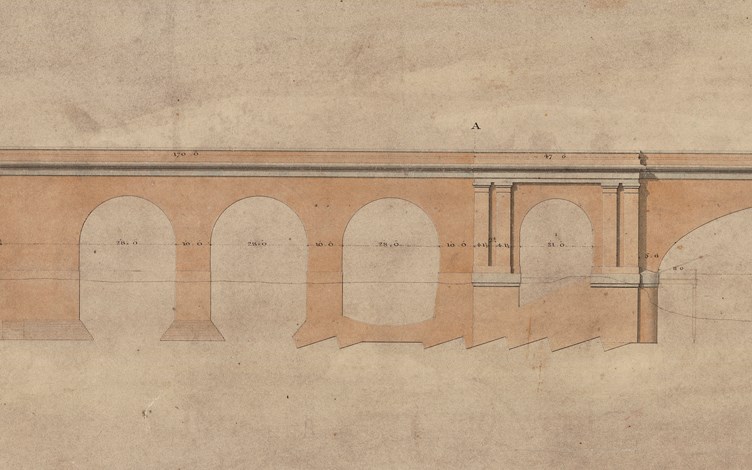Tuesday 28 Feb 2012
HISTORIC IMAGES OF MAIDENHEAD BRIDGE UNVEILED FOR FIRST TIME
- Region & Route:
- | Wales & Western: Western
- | Wales & Western
Historic images of the original architectural drawings of Maidenhead Bridge have been captured and published for the first time on a new Network Rail virtual archive, bringing together 19th century engineering and 21st century technology.
The website www.networkrail.co.uk/virtualarchive celebrates the heritage of today’s railway infrastructure and provides public access to view a special selection of the Network Rail archive, which holds over five million records.
At the time it was built, Isambard Kingdom Brunel’s railway bridge over the River Thames at Maidenhead boasted the flattest yet widest brick constructed arches in the world.
Built entirely of brick, and comprising two shallow spans over the river, which combined a rise of only 24ft (7.3m) with an unprecedented width of 128ft (39m), the design of the bridge caused an engineering sensation when it was completed.
Visitors to the site can chart the history of the railway’s most significant structures and stations including the Forth Bridge, the Tay Bridge, Box Tunnel, and many main line stations. The archive holds records by the most famous railway engineers including Isambard Kingdom Brunel, Robert Stephenson, Joseph Locke and William Henry Barlow.
Network Rail’s archivist Vicky Stretch explains why the online archive is so important. She said: “The history of the railway is so fascinating with some of the oldest records dating back to the 1680s and Charing Cross station with Sir Christopher Wren’s signature. The drawings and documents we hold are an absorbing window to understanding the incredibly detailed and beautiful architectural work carried out by some of the world’s greatest engineers, and are still important for engineers working today.
“We can’t yet showcase anywhere near the five million records we hold but we’ll publish new images and documents all the time and through the ‘ask the archivist’ and blog sections we can share more. We hope this will be a great resource for enthusiasts, historians, architects and students alike. Now everyone can enjoy these amazing drawings and historical documents and learn more about how the railways made Britain what it is today.”
While the drawings date from the earliest days of the railway they are still useful operational records today, as many show information such as foundations and original construction details. The drawings signed by Brunel of Box Tunnel tell us exactly how that tunnel was constructed and this is still important to the running of the railway today.
The oldest records Network Rail holds are from the deeds collection. This collection charts the history of all the land the railway is built on. A set of deeds from 1684 relating to the land Charing Cross is now built on, bears the signature of Sir Christopher Wren (land he once owned was in the 19th century sold to the railway).
With only a small section of the five million articles available for the first phase of the virtual archive, visitors are invited to ‘ask the archivist’ questions about the collection. Enthusiasts can also for the first time purchase a print of their favourite railway image. Network Rail is working with Mediastorehouse to enable people to buy or licence high quality digital images for instant download as well as prints (including framed prints and canvases), key rings, magnets, mugs, mouse mats, jigsaws and greetings cards. All profits from this commercial activity will go back into helping Network Rail manage, maintain and improve Britain’s railways.
The website also has social media sharing functionality, which encourages people to share images with their friends and families.
Notes to editors
Higher resolution images are available to media for publication - please contact the Network Rail press office on 020 3356 8700.
The Network Rail archive team manages documents from the very earliest days of railway construction. Bridges, tunnels, stations, cuttings and embankments designed and built by the nineteenth century’s most dynamic and pioneering engineers are still very much part of today’s operational infrastructure and original documents relating to them are still referred to by today’s railway engineers.
Media Storehouse Ltd have been providing public and professionals image buyers with stunning imagery from some of the worlds best resources for many years. Visit http://www.mediastorehouse.com/ for more information
Contact information
Passengers / community members
Network Rail national helpline
03457 11 41 41
Latest travel advice
Please visit National Rail Enquiries
Journalists
Network Rail press office - South East route
020 3357 7969
southeastroutecomms@networkrail.co.uk
About Network Rail
We own, operate and develop Britain's railway infrastructure; that's 20,000 miles of track, 30,000 bridges, tunnels and viaducts and the thousands of signals, level crossings and stations. We run 20 of the UK's largest stations while all the others, over 2,500, are run by the country's train operating companies.
Usually, there are almost five million journeys made in the UK and over 600 freight trains run on the network. People depend on Britain's railway for their daily commute, to visit friends and loved ones and to get them home safe every day. Our role is to deliver a safe and reliable railway, so we carefully manage and deliver thousands of projects every year that form part of the multi-billion pound Railway Upgrade Plan, to grow and expand the nation's railway network to respond to the tremendous growth and demand the railway has experienced - a doubling of passenger journeys over the past 20 years.
Follow us on Twitter: @networkrail
Visit our online newsroom: www.networkrailmediacentre.co.uk

